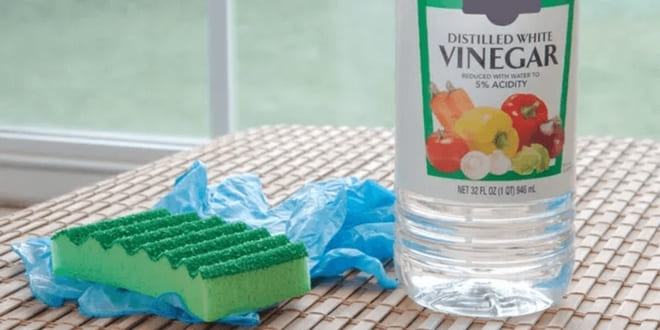
You will not find a single metallic object that doesn’t get rust.
After each rainfall or snowy winter, you will find rust on your motorbike handles, tools, pipes, and even in the car.
What is the solution to get rid of this problem? Yes, you can give a paint coating on some metallic objects but not on all objects.
You will be surprised when you will come to know that one solution is available in your hand distance.
Don’t wrinkle your eyes. The solution is white vinegar.
I believe one question is playing in your mind; why does vinegar remove rust?
In this article, you will get the answer to this question. Also, I will discuss the process of removing rust using vinegar too. Hang on with me.
What is Rust?
Rust happens when metal or metallic objects come in contact with water for an extended period. And combines with oxygen following the oxidation process. As a result, metal gets corroded by the process, and a chalky-reddish substance appears on the metal, known as rust.
The best way to get rid of rust is to keep the surface of metal away from water and keep it dry. But this offer is impractical. You can’t always do it.
You can buy rust-removing products from the market to get rid of rust, but those products are not environment-friendly, and you have to keep them away from children.
Except for those rust-removing products, there are some other solutions available. And the good news is those solutions are available in your home too. If not, purchase it from your nearest store. Out of some available solutions, white vinegar is one of them. White vinegar is an excellent solution for removing rust from any metal.
How White Vinegar Works on Metal to Remove Rust?
If you are irritated enough for stubborn rust, use white vinegar.
Rust gets removed if it comes in contact with acetic acid. And white vinegar is a good source of acetic acid. It is acidic enough that it can dissolve rust with an immediate effect.
More minor things like earrings, keys, rings, bolts, screws, and many more items can eliminate rust if you apply vinegar.
Dip the small items in vinegar, or you can pour vinegar on those items. Then use an old cloth to wipe the rust out. Ensure you have given a thorough rinse after taking it out from the vinegar. Because if vinegar remains on those items, the surface may get damaged.
Step-by-Step Process: Removing Rust Using Vinegar
Step 01: Preparing the Vinegar Solution
Take the Large container and fill it with 1 gallon of distilled white vinegar.
Remember, the container should be made of a non-reactive material like plastic or glass. Mix a cup of table salt well with the white vinegar.
Do you know what the responsibility of salt is in this solution? Adding salt will confirm increasing the acidic potency of the white vinegar. And the solution will be much more effective on rust. You can mix 1 – 2 cups of salt with 1 – 2 gallons of white vinegar for smaller objects.
You are all done preparing the solution.
Step 02: Soaking the Object
Take the rusty object and give it a well-soak to the vinegar and salt solution. The object needs to be well-submerged. Now you have to give a rest to the item for the next 12 hours to a few days based on the level of the rust. If the rust level is less, 24 hours’ rest is enough to remove the rust. But if the rust level is severe, you may need to wait a few days.
Don’t think that you don’t need to do anything except wait after dipping. Look at the item periodically to know how much rust has been removed by the solution from the metal.
Note: Vinegar doesn’t show the same character as all metal-type objects. Let me give you an example. Aluminum items have a protective oxide coating, and vinegar removes this coating before it starts to corrode the aluminum itself. It means aluminum will start damaging if you soak aluminum in vinegar for an extended period.
That is why it is advisable to check the item periodically that is submerged in the solution.
Step 03: Take the Object out of the Solution and Scrub it
Take a pair of rubber or latex gloves and wear them to save your hands from rust. You will find some loosened rust attached to the item. Take a rough item and scrub the loosened rust from the object. The rough item can be steel wool, a brass-bristle brush, or even wrinkled aluminum foil. You can use anything available to you.
Step 04: Rub the Item with a Pad
Take another big container where you must make a solution with water (1 gallon) and baking soda (1 cup). Take the rust-free object and soak it in the solution. Then wait nearly 10 minutes. This way, the acid of the vinegar will neutralize.
After 10 minutes, remove the item from the solution; if required, scrub it again using an abrasive item. Some additional moisture might be available with the item that needs to be removed. To do this, soak a pad in denatured alcohol and rub the item down.
Finally, to keep the item free from rust in the future, use light machine oil and rub it again.
Once you finish the process, don’t forget to give a well-rinse and air dry. If the item remains wet, rust will attack again. And I believe you don’t want this.
Conclusion
Following the above effective process, you can keep many small items safe from rust. It is a scientifically proven process that will work 100% successfully. Don’t forget to give a pat on your back after a successful D.I.Y. project.